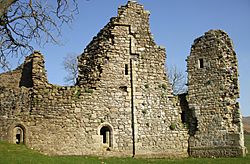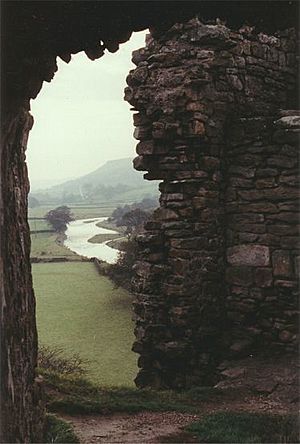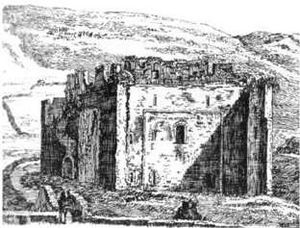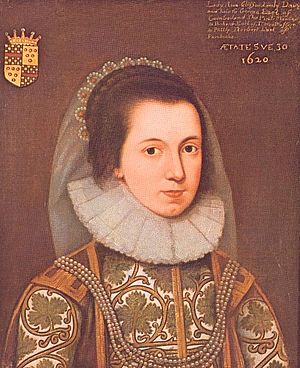Pendragon Castle facts for kids
Quick facts for kids Pendragon Castle |
|
|---|---|
| Cumbria, England | |

|
|
| Coordinates | 54°25′03″N 2°20′20″W / 54.41747°N 2.33898°W |
| Site information | |
| Owner | private |
| Condition | ruins |
| Site history | |
| Built | 12th century |
| Built by | Uther Pendragon according to legend, Ranulph de Meschines according to history |
Pendragon Castle is an old, ruined castle in Cumbria, England. It's found in a beautiful valley called Mallerstang Dale, near the town of Kirkby Stephen. The castle sits high above a bend in the River Eden. It's surrounded by amazing views, with Wild Boar Fell to the southwest and Mallerstang Edge to the east. Pendragon Castle is a very important historical site, listed as a Grade I building.
Contents
Legends of Pendragon Castle
Local stories say that Uther Pendragon built this castle. Uther was the father of the famous King Arthur. Legend says Uther tried to change the path of the River Eden to create a moat around his castle. But he couldn't do it.
A well-known local saying remembers this:
Let Uther Pendragon do what he can,
Eden will run where Eden ran.
Some historians think Uther Pendragon might have been a real leader in the 400s AD. He may have fought against invaders called the Anglo-Saxons. Another legend says Uther and his men died at the castle. It's said that the Saxons poisoned their well.
There are other places in Cumbria linked to King Arthur. One example is King Arthur's Round Table, near Penrith. Many place names in this area, like Penrith and Cumbria, come from old Celtic languages.
History of Pendragon Castle
Even though there are old legends, there's no proof that anyone lived here before the Normans arrived. The castle was built in the 1100s. This was during the time of King William Rufus.
The castle was built by a man named Ranulph de Meschines. You can still see parts of the original Norman keep, which was the main tower. Later, in the 1300s, a toilet tower called a garderobe was added. More changes were made in the 1600s.
Notable Owners of the Castle
One famous owner was Sir Hugh de Morville, Lord of Westmorland. He was one of four knights who murdered St Thomas Becket in 1170. A high point on Mallerstang Edge nearby is named after him, called Hugh Seat.
Another important owner was Lady Idonea de Veteripont. After her husband died, she lived in the castle for many years. She passed away in 1334. Lady Idonea also started the church of St Mary in the nearby village of Outhgill around 1311.
Attacks and Rebuilding
The castle was attacked by Scottish raiding parties two times. First in 1342, and again in 1541. After the second attack, the castle was left in ruins and couldn't be lived in.
Then, the castle came into the hands of Lady Anne Clifford. She was a very strong and determined woman. In 1660, she rebuilt the castle. She also added new buildings like a brewhouse, a bakehouse, stables, and a coach-house. Pendragon Castle was one of her favorite castles. She lived to be 86 years old and died in 1676.
Later Years and Modern Day
After Lady Anne Clifford died, her successor, the Earl of Thanet, didn't want the castle. He took everything valuable from it, even the lead from the roof. By the 1770s, much of the castle had fallen apart. It has slowly decayed since then, becoming the beautiful ruin we see today.
In 1962, the castle was sold at an auction for £525. It was bought by Raven Frankland, who was a landowner and an archaeologist. During the Second World War, Raven's father had written a book about the King Arthur legends connected to the castle. The current owner, John Bucknall, inherited the castle from his cousin Raven and Raven's wife.
In recent years, some of the fallen stones have been cleared away. The crumbling walls have been made stronger. Also, archaeologists from Lancaster University did a small study of the site in 1996.
The castle is still privately owned and sits on farmland. You can visit the outside of the building. However, there is a warning not to go inside the castle walls because they are old and fragile. Some repair work has been done with the help of a grant.
Meaning of the Name Pendragon
The name Pendragon was first written down in 1309. It probably became popular because of the exciting stories about King Arthur that people loved in the Middle Ages.
It's less likely that the name comes from old British words. These words are pen, meaning "head" or "top," and dragon, which could mean "dragon" or "prince" or "warlord." In Welsh, this would be pen draig.
See also
 In Spanish: Castillo de Pendragon para niños
In Spanish: Castillo de Pendragon para niños




